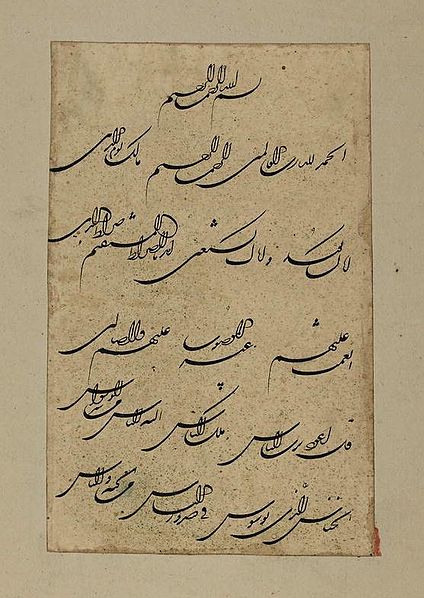 حجم هذا العرض: 424 × 600 بكسلالصورة بدقة كاملة
حجم هذا العرض: 424 × 600 بكسلالصورة بدقة كاملة (1,024 × 1,448 بكسل، حجم الملف: 147 كيلوبايت، نوع الملف: image/jpeg)
| Description |
English: This calligraphic fragment is executed in fine shikastah (literally, "broken") script and includes an initial bismillah and chapters (surahs) 1 and 114 of the Qur'an. At the top appears the first chapter of the Qur'an, entitled al-Fatihah (The Opening).
These two short surahs from the Qur'an appear together here probably because they are short, easily memorized, and recited aloud. It is quite unusual, however, to find Qur'anic verses executed in shikastah, a very fluid script invented in Persia (Iran) by the 18th-century calligrapher Darvish 'Abd al-Majid al-Taliqani (Tavoosi 1987: 34-35). During the 18th and 19th centuries, Qur'ans were written in naskh or nasta'liq, as these scripts were more legible than shikastah. For this reason, this particular fragment stands out as scarce proof that some Qur'anic ayahs were executed in shikastah in Iran during the 18th-19th centuries.
|
| Source |
Library of Congress
|
| Date |
18th-19th centuries
|
| Author |
Unknown calligrapher
|
Permission
(Reusing this image) |
This is a faithful photographic reproduction of an original two-dimensional work of art. The original image comprising the work of art itself is in the public domain for the following reason:
 |
This image (or other media file) is in the public domain because its copyright has expired.
This applies to the United States, Canada, the European Union and those countries with a copyright term of life of the author plus 70 years.
 Note that a few countries have copyright terms longer than 70 years: Mexico has 100 years, Colombia has 80 years, and Guatemala and Samoa have 75 years. This image may not be in the public domain in these countries, which moreover do not implement the rule of the shorter term. Côte d'Ivoire has a general copyright term of 99 years and Honduras has 75 years, but they do implement that rule of the shorter term. Note that a few countries have copyright terms longer than 70 years: Mexico has 100 years, Colombia has 80 years, and Guatemala and Samoa have 75 years. This image may not be in the public domain in these countries, which moreover do not implement the rule of the shorter term. Côte d'Ivoire has a general copyright term of 99 years and Honduras has 75 years, but they do implement that rule of the shorter term.
| | | | | | | | | | | | | | | | | | | | | | | | | | | | | | | | | | | | | | | | | +/-
|
This photographic reproduction is therefore also in the public domain.
| | | | | | | | | | | | | | | | | | | | | | | | | | +/-
|
|
وصلات
الصفحات التالية تحتوي على وصلة لهذه الصورة:
